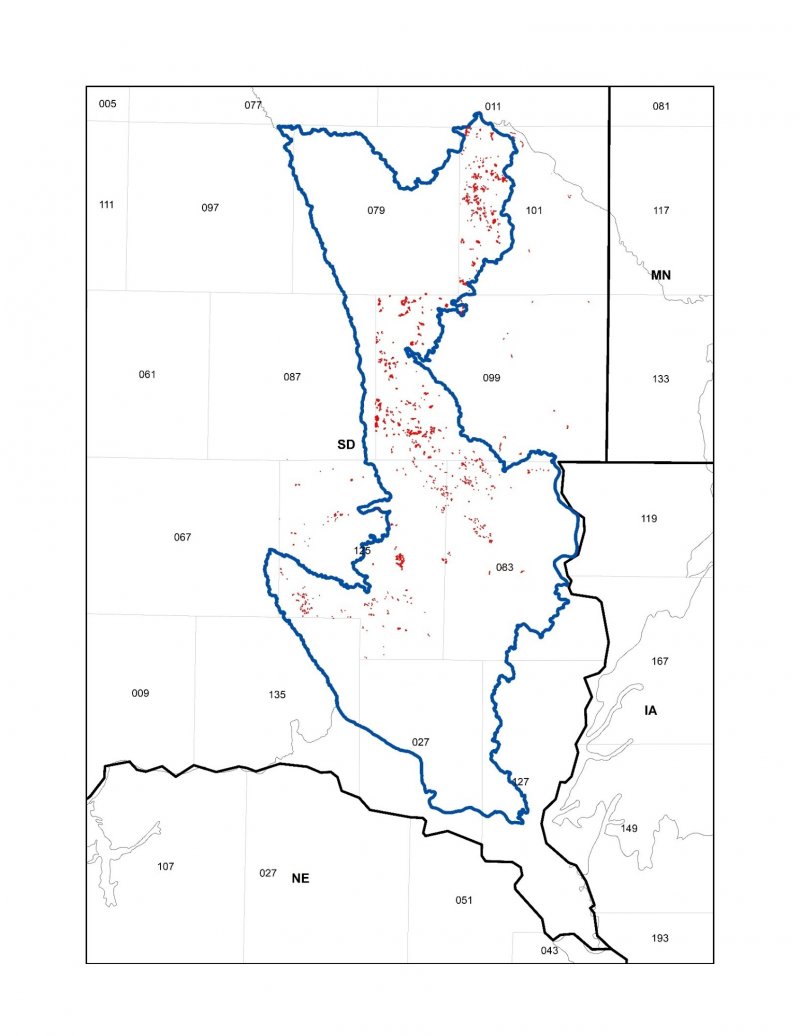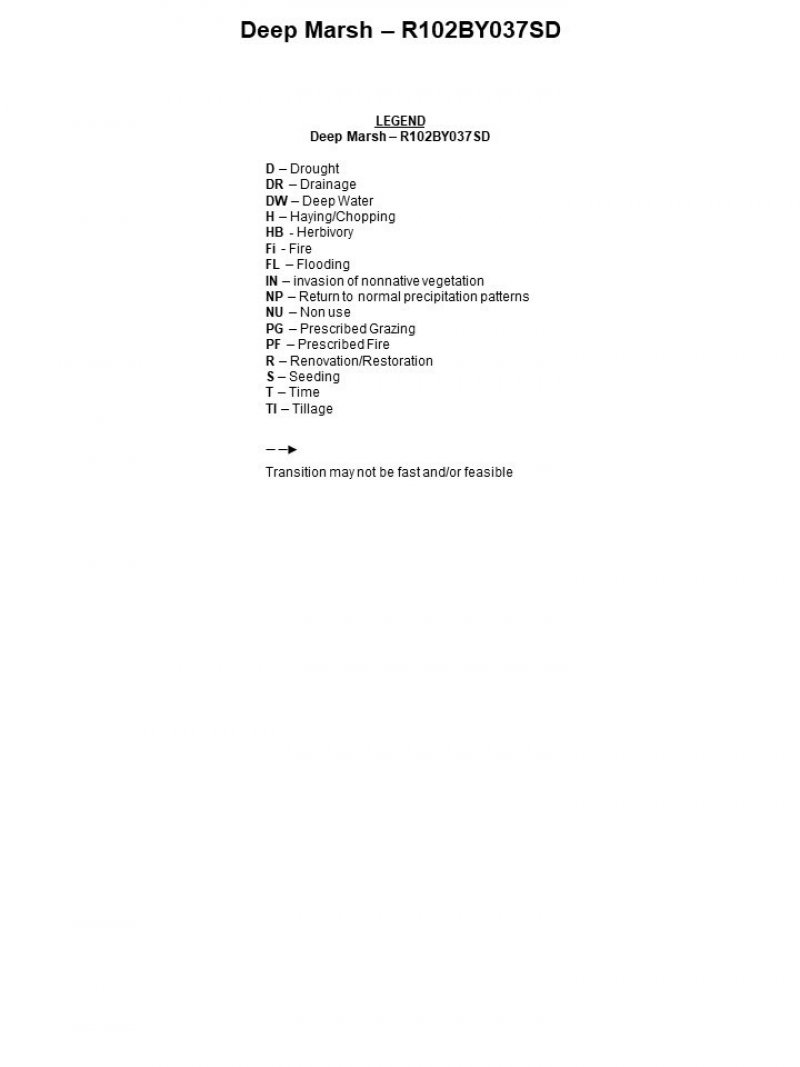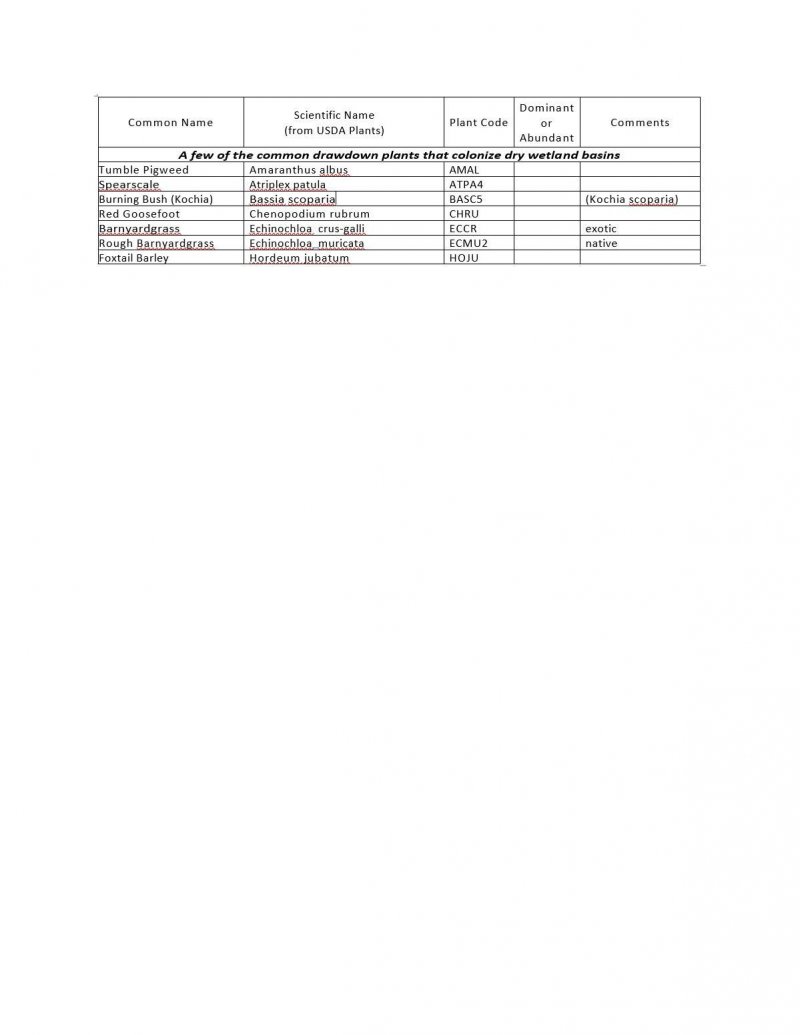
Natural Resources
Conservation Service
Ecological site R102BY037SD
Deep Marsh
Last updated: 2/01/2024
Accessed: 12/31/2024
General information
Provisional. A provisional ecological site description has undergone quality control and quality assurance review. It contains a working state and transition model and enough information to identify the ecological site.
MLRA notes
Major Land Resource Area (MLRA): 102B–Till Plains
The Till Plains (102B) is located within the Western Lake Section of the Central Lowland Province of the Interior Plains. It is entirely in South Dakota, encompassing 2,215 square miles (Figure 1). The elevation ranges from 1,140 to 1,880 feet. The MLRA is characterized by glaciated, nearly level to hilly plains populated by stagnation and end moraines, glacial outwash terraces, and floodplains as the major landforms. The dominant parent materials are silty drift, glacial till, glacial outwash, and alluvium. (USDA-NRCS, 2006)
The dominant soil order in this MLRA is Mollisols. The soils in the area dominantly have a mesic temperature regime, a udic ustic moisture regime and mixed or smectitic mineralogy. They generally are very deep, well drained to poorly drained, and clayey or loamy. This area is in the western area of the tall grass prairie and supports big bluestem (Andropogon gerardi), little bluestem (Schizachyrium scoparium), Indiangrass (Sorghastrum nutans), porcupine grass (Hesperostipa spartea), and green needlegrass (Nassella viridula) as the dominant native species. Cattails (Typha), prairie cordgrass (Spartina pectinate), bulrush (Cyperaceae) and reed canarygrass (Phalaris arundinacea) are commonly found on the poorly drained soils. (USDA-NRCS, 2006).
Classification relationships
Major Land Resource Area (MLRA): Till Plains (102B) (USDA-NRCS, 2006)
USFS Subregions: North Central Glaciated Plains Section (251B); Outer Coteau des Prairies (251Bb); Yankton Hills and Valleys (251Bf); Northwest Iowa Plains (251Bd); (Cleland et al., 2007).
US EPA Level IV Ecoregion: Prairie Coteau (46k); James River Lowland (46n); Loess Prairies (47a); Big Sioux Basin (46m) - (USEPA, 2013)
Ecological site concept
The Deep Marsh ecological site typically represents the central portion of a wetland basin or depression on a glaciated prairie landscape with standing water up to five feet deep, and at least some tall, emergent vegetation like cattails, bulrushes, and reeds. In most years there is at least some standing water but in drought years the basin surface may dry out to retain groundwater within one foot of the surface. Ponded water conditions and very slow permeability strongly influence the soil-water-plant relationship. Most uncultivated wetland basins in this MLRA have concentric bands of distinctly different vegetation corresponding with changes in soil and water depth.
Associated sites
| R102BY001SD |
Shallow Marsh These sites occur in a basin or closed depression. Soils are very poorly drained and the site will pond water until early summer in most years. The central concept soil series are Baltic and Worthing, but other series are included. |
|---|---|
| R102BY006SD |
Limy Subirrigated These sites occur along the edges of drainageways. Soils are somewhat poorly drained which have a water table within two to five feet of the soil surface that persists longer than the wettest part of the growing season, typically until the month of August. Soils will effervesce with acid at or near the surface. The central concept soil series are Davison and Wakonda, but other series are included. |
| R102BY010SD |
Loamy These sites occur on upland areas. The soils are well drained and have less than 40 percent clay in the surface and subsoil. The central concept soil series are Egan and Wentworth, but other series are included. |
Similar sites
| R102BY001SD |
Shallow Marsh The Shallow Marsh site is in a similar landscape position, but the site ponds water until early summer in most years. |
|---|
Table 1. Dominant plant species
| Tree |
Not specified |
|---|---|
| Shrub |
Not specified |
| Herbaceous |
(1) Typha |
Click on box and path labels to scroll to the respective text.
Ecosystem states
| T1A | - | Inundation, flooding, drought |
|---|---|---|
| T1B | - | Tillage, drought |
| T1C | - | Drought |
| T2A | - | Deep water, prescribed grazing, prescribed fire, drought, time |
| T2B | - | Tillage, drought |
| T2C | - | Drought, drainage |
| T3A | - | Non-use, inundation, flooding, Tillage, Seeding |
| T4A | - | Renovation/restoration |
State 1 submodel, plant communities
| 1.1A | - | Flooding, herbivory |
|---|---|---|
| 1.2A | - | Drought |
| 1.3A | - | Return to normal precipitation patterns, time |
| 1.4A | - | Return to normal precipitation patterns, time |
State 2 submodel, plant communities
| 2.1A | - | Deep water, herbivory, prescribed grazing, flooding, haying/chopping, fire |
|---|---|---|
| 2.2A | - | Drought |
| 2.3A | - | Return to normal precipitation patterns, time |
| 2.4A | - | Time |




